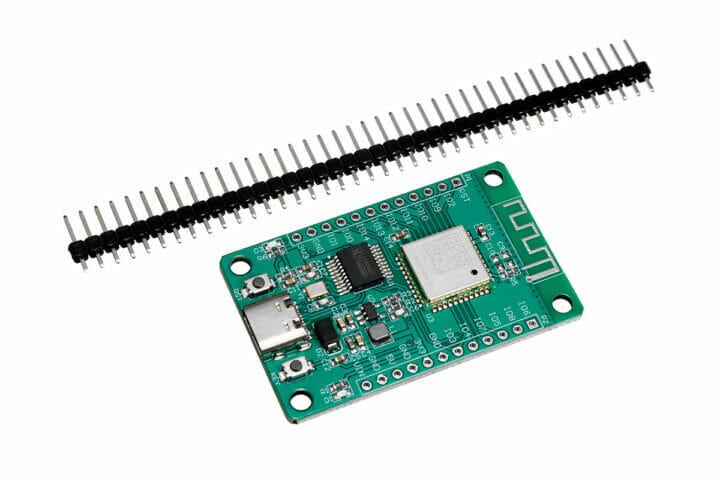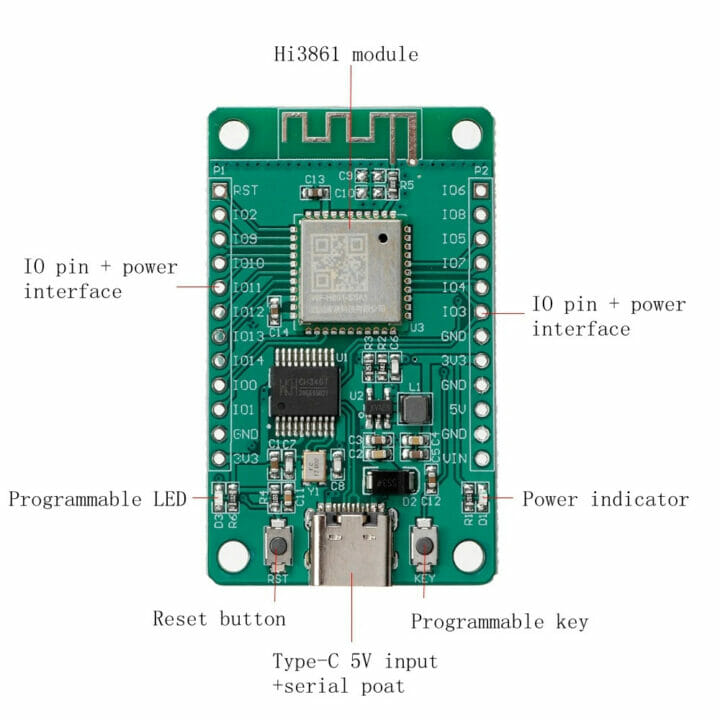Last year, we noted the Hisilicon Hi3861 based HiSpark WiFi IoT development board with supports LiteOS and HarmonyOS that was available in China for just under $10, or as part of a devkit with baseboard and modules for around $60.
Although not very practical, buying from Taobao was possible, but there’s now what appears to be a new revision of the Hi3861V100 based HarmonyOS development board in a wider form factor on Banggood for $10.99.
 Hi3861 development board specifications:
Hi3861 development board specifications:
- MCU – Hisilicon Hi3861V100 32-bit RISC-V microcontroller @ up to 160 MHz with 352 KB SRAM and 288 KB ROM, 2 MB flash memory, and WiFI 4 connectivity; QFN-32 5x5mm package
- WiFi
- 802.11b/g/n standard up to 72.2 Mbps @ HT20
- 2.4 GHz frequency band (ch1-ch14).
- Station (STA) and access point (AP) modes with up to 6 clients for the latter
- WiFi mesh with up to 256 nodes
- Security – WPA, WPA2 personal, and WPS 2.0
- PCB antenna
- USB – 1x USB Type-C port for power and programming via CH340 chip
- Expansion – 2x headers with up to 2x SPI, 2x I2C, 3x UART interfaces, 15x GPIO, 7x ADC inputs, 6x PWM interfaces, 1x I2S
- Misc – Reset and user buttons, power and user LEDs,
jumper to select boot mode - Power Supply – 5V via USB-C port or pin header
- Power consumption for Hi3861V100 chip
- Ultra-deep sleep mode: 3 μA @ 3.3 V
- DTIM1: 1.27 mA @ 3.6 V
- DTIM3: 0.526 mA @ 3.6 V
- DTIM10: 0.233 [email protected] V
- Dimensions – 50 x 31 mm
- Weight – 7 grams
- Temperature Range – –40°C to +85°C (for the chip, not listed for the board)
 It’s basically the same as the original board, but just wider (30 vs 20 mm), and it adds user and power LED’s, and does without the boot selection jumper. HiSilicon also updated the power consumption numbers that have improved since last year. The board is clearly designed for WiFi IoT applications such as the Smart Home, and the company says it is suitable as a learning platform for college students and electronic enthusiasts.
It’s basically the same as the original board, but just wider (30 vs 20 mm), and it adds user and power LED’s, and does without the boot selection jumper. HiSilicon also updated the power consumption numbers that have improved since last year. The board is clearly designed for WiFi IoT applications such as the Smart Home, and the company says it is suitable as a learning platform for college students and electronic enthusiasts.
English documentation is still available on HarmonyOS website, and the company provides the “Huawei DevEco Device Tool” for Windows and Ubuntu in order to develop, build, flash, and debug HarmonyOS. The instructions rely on a Linux server for the build, and a Windows machine running Visual Studio Code, but it might be possible to do everything on a Linux machine since the latter is also available for Ubuntu.

Jean-Luc started CNX Software in 2010 as a part-time endeavor, before quitting his job as a software engineering manager, and starting to write daily news, and reviews full time later in 2011.
Support CNX Software! Donate via cryptocurrencies, become a Patron on Patreon, or purchase goods on Amazon or Aliexpress





But why? I just bought 25 ESP32-C3 boards for $1.35 each from Aliexpress.
I think It’s mostly for people/students who want to learn or get started with the HarmonyOS platform.
Link?
I was half asleep when I wrote that, I got them on taobao and they were modules not dev boards. The dev boards run about $3.00 on Aliexpress.
I found the Huawei development environment very complicated. Also the HUAWEI DevEco Device Tool is not available: https://device.harmonyos.com/en/ide
If you switch the language to Chinese, you’ll get download links for the Windows and Linux versions.
But I gave up… Not only do they need email registration for download, but they want your phone number to retrieve your password if you forget it.
It’s a recurring problem with development tools from China.
So we stay with esp’s then.
Coming somewhat late to the party: Are you suggesting that there’s a HarmonyOS image for RISC-V?
Yes for that board.
That’s very interesting. Thank you.
(It seems to be a bit of an impediment that RISC-V images are not generic)